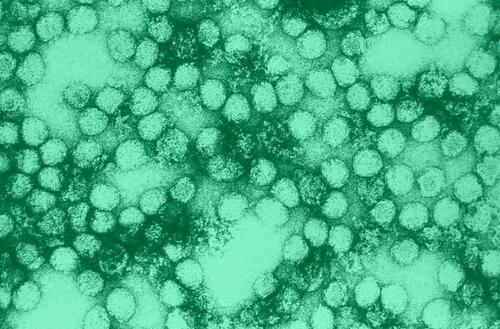
Authored by Jack Phillips via The Epoch Times (emphasis ours),
The mosquito-transmitted illness yellow fever, which caused havoc in the South during the 1800s, may see a resurgence in the United States, according to a new study.
“Currently, the U.S. population is nearly entirely unvaccinated against yellow fever, and there are no vaccine doses in the U.S. Strategic National Stockpile,” wrote the authors of a recent paper in the New England Journal of Medicine.

They continued to say: “During a sizable epidemic, yellow fever could tear quickly through unimmunized populations across the American South, and it is unlikely that the U.S. government would be prepared to acquire and distribute vaccines in a timely manner, even if there were public demand.”
The authors said that large populations in southeastern U.S. cities like Galveston, Texas; Houston, Texas; New Orleans, Louisiana; Mobile, Alabama; Tampa, Florida; and Corpus Christi, Texas, could lead to an epidemic of the virus, which is spread via the Aedes aegypti mosquito.
“During the 1800s, yellow fever caused highly lethal and economically devastating urban epidemics in southern U.S. coastal cities and those on the Mississippi River,” the authors stated. “It was sometimes known as ‘yellow jack,’ from the name of a nautical flag hoisted from ships arriving from the Caribbean that were quarantined because of suspected cases of the disease.”
According to the U.S. Centers for Disease Control and Prevention (CDC), yellow fever has no cure and those who develop severe disease have a high chance of death. But the CDC stressed that it is a "very rare cause of illness" in the United States and is spread via Aedes aegypti mosquitoes, which officials say are found in parts of South America and Africa.
The virus cannot be spread from person to person. One cannot transmit yellow fever through coughing, and it can only be spread via infected mosquitoes, according to officials.
The Cleveland Clinic's website says that a yellow fever-infected person can transmit the virus to a mosquito that bites them, and the mosquito can then transmit it to another person after it bites them. "If you’ve been diagnosed with yellow fever, continue to cover up. You don’t want a mosquito to bite you and then bite someone else," the website says.
However, there is no cure. Officials advise that anyone going to tropical areas should receive the yellow fever vaccine.
"Occasionally, infected travelers have exported cases to countries that are free of yellow fever," says the World Health Organization on its website. "However, the disease can only spread easily to a new country if there are mosquito species able to transmit it, specific climatic conditions, and the animal reservoir needed to maintain it."
Symptoms of the virus include fever, headache, muscle pain, body aches, vomiting, and nausea. Severe forms of the disease can lead to organ failure, hemorrhaging, and jaundice (the yellowing of the eyes and skin).
Advertisement - Story continues below
However, many people don't experience symptoms at all, the WHO says, and most people who do develop symptoms see them disappear in three to four days. But it notes that a "small percentage" of yellow fever cases can enter a "more toxic phase" after 24 hours of recovering from the initial symptoms, with a high fever and multiple organs being impacted.
"In this phase, people are likely to develop jaundice (yellowing of the skin and eyes, hence the name yellow fever), dark urine, and abdominal pain with vomiting. Bleeding can occur from the mouth, nose, eyes, or stomach. Half of these patients die within 7 [to] 10 days," the WHO says
The virus is also difficult to diagnose in its early stages, the U.N. organization says, because it appears similar to other illnesses.
"More severe cases can be confused with severe malaria, leptospirosis, viral hepatitis (especially fulminant forms), other hemorrhagic fevers, infection with other flaviviruses (such as dengue hemorrhagic fever) and poisoning," the WHO website says. "Polymerase chain reaction (PCR) testing in blood and urine can sometimes detect the virus in early stages of the disease. In later stages, testing to identify antibodies is needed."
Each year, yellow fever is blamed for the deaths of about 30,000 people around the world, says the Cleveland Clinic's website. Around 200,000 people annually are infected with the virus, it says. Most of the cases and deaths occur within Africa.
Yellow fever outbreaks killed thousands of people per year in a number of U.S. cities between 1793 and 1905 AD, according to researchers. Thousands of people died in various outbreaks in northern cities such as Philadelphia, New York City, and Boston, it found. However, those outbreaks appeared to occur mainly in the southeastern U.S.
Experts say that people can protect themselves against mosquitoes in the warmer months by wearing protective clothing and using insect repellent.
“We believe yellow fever should be prioritized as part of our national pandemic-preparedness efforts, given that the conditions are now in place for yellow jack to return and sicken many people in southern U.S. cities,” the report authors recently wrote.
Authored by Jack Phillips via The Epoch Times (emphasis ours),
The mosquito-transmitted illness yellow fever, which caused havoc in the South during the 1800s, may see a resurgence in the United States, according to a new study.
“Currently, the U.S. population is nearly entirely unvaccinated against yellow fever, and there are no vaccine doses in the U.S. Strategic National Stockpile,” wrote the authors of a recent paper in the New England Journal of Medicine.

They continued to say: “During a sizable epidemic, yellow fever could tear quickly through unimmunized populations across the American South, and it is unlikely that the U.S. government would be prepared to acquire and distribute vaccines in a timely manner, even if there were public demand.”
The authors said that large populations in southeastern U.S. cities like Galveston, Texas; Houston, Texas; New Orleans, Louisiana; Mobile, Alabama; Tampa, Florida; and Corpus Christi, Texas, could lead to an epidemic of the virus, which is spread via the Aedes aegypti mosquito.
“During the 1800s, yellow fever caused highly lethal and economically devastating urban epidemics in southern U.S. coastal cities and those on the Mississippi River,” the authors stated. “It was sometimes known as ‘yellow jack,’ from the name of a nautical flag hoisted from ships arriving from the Caribbean that were quarantined because of suspected cases of the disease.”
According to the U.S. Centers for Disease Control and Prevention (CDC), yellow fever has no cure and those who develop severe disease have a high chance of death. But the CDC stressed that it is a “very rare cause of illness” in the United States and is spread via Aedes aegypti mosquitoes, which officials say are found in parts of South America and Africa.
The virus cannot be spread from person to person. One cannot transmit yellow fever through coughing, and it can only be spread via infected mosquitoes, according to officials.
The Cleveland Clinic’s website says that a yellow fever-infected person can transmit the virus to a mosquito that bites them, and the mosquito can then transmit it to another person after it bites them. “If you’ve been diagnosed with yellow fever, continue to cover up. You don’t want a mosquito to bite you and then bite someone else,” the website says.
However, there is no cure. Officials advise that anyone going to tropical areas should receive the yellow fever vaccine.
“Occasionally, infected travelers have exported cases to countries that are free of yellow fever,” says the World Health Organization on its website. “However, the disease can only spread easily to a new country if there are mosquito species able to transmit it, specific climatic conditions, and the animal reservoir needed to maintain it.”
Symptoms of the virus include fever, headache, muscle pain, body aches, vomiting, and nausea. Severe forms of the disease can lead to organ failure, hemorrhaging, and jaundice (the yellowing of the eyes and skin).
Advertisement – Story continues below
However, many people don’t experience symptoms at all, the WHO says, and most people who do develop symptoms see them disappear in three to four days. But it notes that a “small percentage” of yellow fever cases can enter a “more toxic phase” after 24 hours of recovering from the initial symptoms, with a high fever and multiple organs being impacted.
“In this phase, people are likely to develop jaundice (yellowing of the skin and eyes, hence the name yellow fever), dark urine, and abdominal pain with vomiting. Bleeding can occur from the mouth, nose, eyes, or stomach. Half of these patients die within 7 [to] 10 days,” the WHO says
The virus is also difficult to diagnose in its early stages, the U.N. organization says, because it appears similar to other illnesses.
“More severe cases can be confused with severe malaria, leptospirosis, viral hepatitis (especially fulminant forms), other hemorrhagic fevers, infection with other flaviviruses (such as dengue hemorrhagic fever) and poisoning,” the WHO website says. “Polymerase chain reaction (PCR) testing in blood and urine can sometimes detect the virus in early stages of the disease. In later stages, testing to identify antibodies is needed.”
Each year, yellow fever is blamed for the deaths of about 30,000 people around the world, says the Cleveland Clinic’s website. Around 200,000 people annually are infected with the virus, it says. Most of the cases and deaths occur within Africa.
Yellow fever outbreaks killed thousands of people per year in a number of U.S. cities between 1793 and 1905 AD, according to researchers. Thousands of people died in various outbreaks in northern cities such as Philadelphia, New York City, and Boston, it found. However, those outbreaks appeared to occur mainly in the southeastern U.S.
Experts say that people can protect themselves against mosquitoes in the warmer months by wearing protective clothing and using insect repellent.
“We believe yellow fever should be prioritized as part of our national pandemic-preparedness efforts, given that the conditions are now in place for yellow jack to return and sicken many people in southern U.S. cities,” the report authors recently wrote.
Loading…





